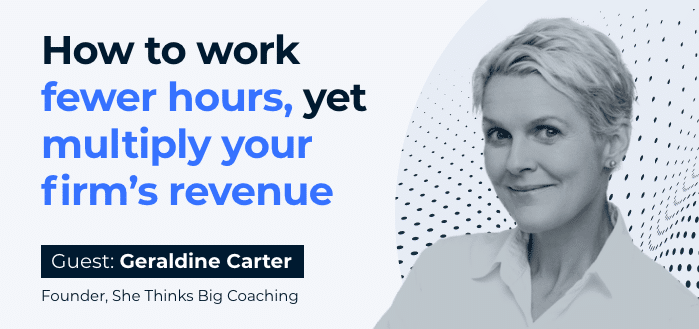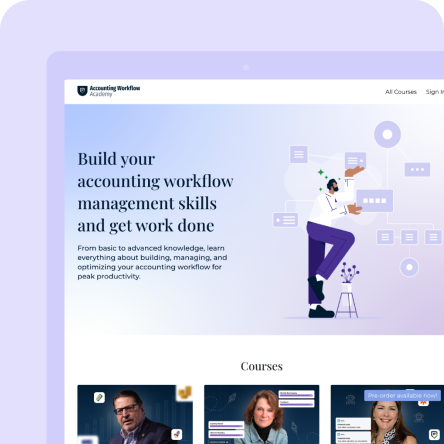Learn the strategies Geraldine Carter (Founder at She Thinks Big Coaching) uses to help her clients move from 70-hour work weeks to 5-hour work weeks while doubling, sometimes tripling their annual revenues.
At first glance, this topic may look and sound like a bait.
But it isn’t.
Reducing your work hours and doubling your revenue should not look like scenarios that are out of reach.
Take Geraldine’s client for example:
She decided to narrow down her services to the farming industry only. A risky move since farming is a seasonal business. She started by speaking to her current farming clients about what they needed and the goals they wanted to achieve.
Using the insights she gained from talking to her clients, she designed packages that moved typical tax-only clients into high-paying and high margin clients.
The end result: She went from working 70 hours a week to working about 5 hours a week. And ended up increasing her annual revenue by $400K.
What made the difference? She recognized the value she could offer and delivered on it.
Our goal with Firm Founders Live is to help you with the tools and resources you need to build a successful and progressive firm. We continue to do this by collaborating with industry experts who know what they are talking about and have worked with many firm founders.
Working Few Hours and Multiplying Your Firm’s Revenue
In this article, you’ll find Geraldine’s thoughts on:
- What value is and why it is important
- How to create value
- How to understand the transformation your clients seek
- Why value-based pricing is the way to go
- How to package your services
…and answers to the questions that were asked by the audience during the livestream.
Geraldine Carter is a fantastic business coach and founder of She Thinks Big Coaching.
Continue reading or watch the full episode below:
Value 101
The key to working fewer hours and earning more is to understand what your clients value so that you can design services that they consider valuable.
How to Identify and Create Value
Find a niche or narrow down your service offerings to a specific group of clients
This is one of the ways to easily identify and create value. When you narrow down your service offerings to a specific group of people, your clients tend to look like each other. And the more they look like each other, the more they’re in the same industry, the more they’re in the same revenue band, the more they will tend to value the same kinds of things, thereby making it easier to design your packages and capture value for them.
Talk to your existing clients
To create value, you need to talk to your existing clients and understand what it is they want. What’s the experience that they want from their accountant or CPA? And where is it that they’re trying to go? What is the transformation that they’re seeking? Are they trying to go from 1 million to 3 million in revenue over the next five years? Are they trying to go from two rental properties to four? What is it that they are trying to create? And once you understand the transformation that they are seeking, then you can design your services.
The more you create value, the higher your prices become. If you are doing a high margin, high value kind of work, the fewer clients you will need to take on and the lighter your workload will become.
How to Find what Your Clients Consider Valuable
Think about your current customers
You’ve been working with your clients for a long time and have a sense of what they need. So start from there. Think about any one of your really good clients who for example is a high quality business owner but doesn’t necessarily have their financials all organized. If you had all the time in the world to spend with them, what would you do to help them grow their revenue, save money, or organize their finances? List them out and you would have found a couple of ways to provide value to them.
Dig into The Conversations You’ve had With Your Clients
The second way is to look into all the conversations you’ve had with your clients, and all the things they’ve said to you about what’s helpful. Think about all the questions that they’ve come to you with, those are things that they’re wanting help with. So you can go right to information that you already have. From conversations with existing clients, and what you already know based on years of experience.
Schedule a Meeting With Your Clients and Talk to Them
The third way is to simply talk to your clients to schedule a simple meeting with them. You don’t have to have 20 meetings, you can typically get what you need in 4 to 6 meetings with different clients because patterns will appear. After a couple of meetings, you’ll begin to get the same answers again and again.
During the call, ask them questions like:
- What is it that you’re trying to create in your business?
- Where are you trying to go? Where are you struggling?
- What is it that you don’t know that you wish you knew?
Asking them such questions will uncover all kinds of ways that you can help them.
Why Value-based Pricing is Great for Accounting Services
It’s always better to focus on the transformation that your clients are looking for and making it a high quality experience. This is where once again, the fingerprints of hourly billing are all over accounting businesses. The thinking is “I have to do work in order to make money”.
“Work isn’t what makes money. Value is.
– Geraldine Carter
And many of us who grew up with hourly wage jobs have a tendency to think that work is what makes money because we got paid for the hours that we worked. And then when you start your firm, you go ahead and charge for the hour that you work. But that’s not where the value is, that just happens to be the metric that they choose to use to price their services.
If you would like to work fewer hours and still protect your revenue, the path to doing that is focusing on the experience and the transformation for the client. And then use pricing tools to capture that value.
How to Price & Package Your Service Offerings
A Great way to price your services is using the Bronze, Silver, Gold tiered flat-rate pricing. This pricing tool is designed with a certain kind of buyer in mind. This comes back to niching.
When you work with a similar group of clients, the outcomes they want will be similar, making it easy for you to design your packages.
Using the bronze, silver, gold pricing tool also allows your client to choose their preferred tier.
Another pricing tool is the single one hour strategy session and a half-day VIP day that you flat rate. This enables a client to work with you without having to become your ongoing accounting client. So it bridges the gap between what is a big decision for your buyer of “Do I switch all of my accounting over to this person? Or am I not ready yet?”
More resources for you:
Increase Your Rates Without Losing Clients (+ 2 Free Templates) with Loren Fogelman
How To Identify Ideal Clients For Your Accounting Firm with Richard Roppa-Roberts
Q&A
Q: How many niches are too many to focus on?
At the onset, one is the best. Because when you focus on one, you dig deep into the expertise of that niche. And it makes what you need to study so much easier. It really narrows down the scope of what you need to be an expert on. And the more you can narrow down, the more you’ll set yourself apart and separate yourself from the pack.
Once you’ve mastered that, you can decide to bolt on another niche. But mastering the process of one niche is plenty of work in itself. So I recommend one just to keep your life simple.
Q: What should I include in my service packages?
What to put in each subclass is really based on what the buyer is looking for in terms of transformation.
And then you ask yourself, what do I need? What do they need? In terms of services? In terms of do they need accounts payable? Do they need accounts receivable? Do they need payroll? And if the answer is yes, then you add it in? If the answer is no, you don’t include it. But you just design, you design the package that’s going to get their desired outcome.
The opposite of that is kind of building from the ground up and just tossing it out and hoping that people pick it up, which is a much harder sell and a heavier lift. So go out to the end, begin with the end in mind of what problem you’re trying to solve for them, what problems they want solved, and then design your packages.
Q: How do I get clients outside my geographical zone?
Whether your prospects live in America or Canada, or in any other geography, come at it from the direction of what is the problem that I want to solve for them? And once you figure that out, package, price and sell that only.
But then how do you get in front of them? This comes back to the value of having a niche and working with a narrow band of clients. It makes it easier to speak directly to their problems. And when you can speak directly to their problems, it makes it so much easier for them to find you and to buy from you.
If you want to get up and out of your geography, some ways to do it are:
- Getting on either on other people’s podcasts or creating your own.
- Having a website that speaks directly to your clients challenges and how you can help them solve them.
- Creating an email list is another way to capture you capture their email addresses, you answer the questions you know they have.
- Another way is to create a Facebook group. But if you create a Facebook group, you’ve got to capture you know, foot traffic. They might not just wander by your door so you have to get out and promote it. That’s where podcasting and other forms of writing come in incredibly handy especially, especially for people who want to rise up out of their zip code.
I live in a town of 3000 people buried in the mountains of Idaho. I don’t have a single client within a 500 mile radius. I knew I was limited by geography, but I saw it as an opportunity. Which was for me, in my case, podcast. So you can absolutely make it work when you talk about solving people’s problems in plain English in a way that it relates directly to them.
Q: How do I overcome client’s objections to price increases?
This is what I always advice my clients to do especially because they use the tiered pricing model:
You make bronze, silver, gold packages and you take your existing clients, and you put their existing price in between bronze and silver.
That way they can step down if they want to. But you also give them the option to step up into silver and gold. And it gives them a choice so that they don’t feel like it’s a take it or leave it.
I just wrote a seven series email on seven ways to increase your prices on existing clients. So you can scoop that up at my website.
Geraldine is the founder of She Thinks Big Coaching, where she helps CPAs get out of the accounting rut, write their own rules, and create the businesses they want to own.







